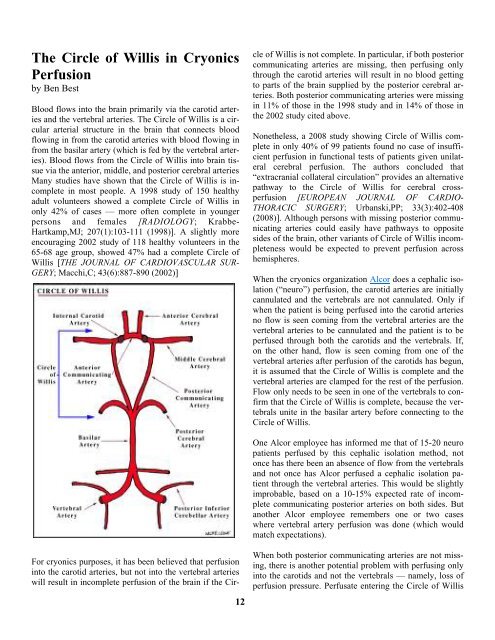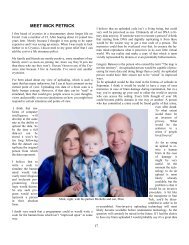The Circle of Willis in Cryonics Perfusion
The Circle of Willis in Cryonics Perfusion
The Circle of Willis in Cryonics Perfusion
Create successful ePaper yourself
Turn your PDF publications into a flip-book with our unique Google optimized e-Paper software.
<strong>The</strong> <strong>Circle</strong> <strong>of</strong> <strong>Willis</strong> <strong>in</strong> <strong>Cryonics</strong><br />
<strong>Perfusion</strong><br />
by Ben Best<br />
Blood flows <strong>in</strong>to the bra<strong>in</strong> primarily via the carotid arteries<br />
and the vertebral arteries. <strong>The</strong> <strong>Circle</strong> <strong>of</strong> <strong>Willis</strong> is a circular<br />
arterial structure <strong>in</strong> the bra<strong>in</strong> that connects blood<br />
flow<strong>in</strong>g <strong>in</strong> from the carotid arteries with blood flow<strong>in</strong>g <strong>in</strong><br />
from the basilar artery (which is fed by the vertebral arteries).<br />
Blood flows from the <strong>Circle</strong> <strong>of</strong> <strong>Willis</strong> <strong>in</strong>to bra<strong>in</strong> tissue<br />
via the anterior, middle, and posterior cerebral arteries<br />
Many studies have shown that the <strong>Circle</strong> <strong>of</strong> <strong>Willis</strong> is <strong>in</strong>complete<br />
<strong>in</strong> most people. A 1998 study <strong>of</strong> 150 healthy<br />
adult volunteers showed a complete <strong>Circle</strong> <strong>of</strong> <strong>Willis</strong> <strong>in</strong><br />
only 42% <strong>of</strong> cases — more <strong>of</strong>ten complete <strong>in</strong> younger<br />
persons and females [RADIOLOGY; Krabbe-<br />
Hartkamp,MJ; 207(1):103-111 (1998)]. A slightly more<br />
encourag<strong>in</strong>g 2002 study <strong>of</strong> 118 healthy volunteers <strong>in</strong> the<br />
65-68 age group, showed 47% had a complete <strong>Circle</strong> <strong>of</strong><br />
<strong>Willis</strong> [THE JOURNAL OF CARDIOVASCULAR SUR-<br />
GERY; Macchi,C; 43(6):887-890 (2002)]<br />
For cryonics purposes, it has been believed that perfusion<br />
<strong>in</strong>to the carotid arteries, but not <strong>in</strong>to the vertebral arteries<br />
will result <strong>in</strong> <strong>in</strong>complete perfusion <strong>of</strong> the bra<strong>in</strong> if the Cir-<br />
12<br />
cle <strong>of</strong> <strong>Willis</strong> is not complete. In particular, if both posterior<br />
communicat<strong>in</strong>g arteries are miss<strong>in</strong>g, then perfus<strong>in</strong>g only<br />
through the carotid arteries will result <strong>in</strong> no blood gett<strong>in</strong>g<br />
to parts <strong>of</strong> the bra<strong>in</strong> supplied by the posterior cerebral arteries.<br />
Both posterior communicat<strong>in</strong>g arteries were miss<strong>in</strong>g<br />
<strong>in</strong> 11% <strong>of</strong> those <strong>in</strong> the 1998 study and <strong>in</strong> 14% <strong>of</strong> those <strong>in</strong><br />
the 2002 study cited above.<br />
Nonetheless, a 2008 study show<strong>in</strong>g <strong>Circle</strong> <strong>of</strong> <strong>Willis</strong> complete<br />
<strong>in</strong> only 40% <strong>of</strong> 99 patients found no case <strong>of</strong> <strong>in</strong>sufficient<br />
perfusion <strong>in</strong> functional tests <strong>of</strong> patients given unilateral<br />
cerebral perfusion. <strong>The</strong> authors concluded that<br />
“extracranial collateral circulation” provides an alternative<br />
pathway to the <strong>Circle</strong> <strong>of</strong> <strong>Willis</strong> for cerebral crossperfusion<br />
[EUROPEAN JOURNAL OF CARDIO-<br />
THORACIC SURGERY; Urbanski,PP; 33(3):402-408<br />
(2008)]. Although persons with miss<strong>in</strong>g posterior communicat<strong>in</strong>g<br />
arteries could easily have pathways to opposite<br />
sides <strong>of</strong> the bra<strong>in</strong>, other variants <strong>of</strong> <strong>Circle</strong> <strong>of</strong> <strong>Willis</strong> <strong>in</strong>completeness<br />
would be expected to prevent perfusion across<br />
hemispheres.<br />
When the cryonics organization Alcor does a cephalic isolation<br />
(“neuro”) perfusion, the carotid arteries are <strong>in</strong>itially<br />
cannulated and the vertebrals are not cannulated. Only if<br />
when the patient is be<strong>in</strong>g perfused <strong>in</strong>to the carotid arteries<br />
no flow is seen com<strong>in</strong>g from the vertebral arteries are the<br />
vertebral arteries to be cannulated and the patient is to be<br />
perfused through both the carotids and the vertebrals. If,<br />
on the other hand, flow is seen com<strong>in</strong>g from one <strong>of</strong> the<br />
vertebral arteries after perfusion <strong>of</strong> the carotids has begun,<br />
it is assumed that the <strong>Circle</strong> <strong>of</strong> <strong>Willis</strong> is complete and the<br />
vertebral arteries are clamped for the rest <strong>of</strong> the perfusion.<br />
Flow only needs to be seen <strong>in</strong> one <strong>of</strong> the vertebrals to confirm<br />
that the <strong>Circle</strong> <strong>of</strong> <strong>Willis</strong> is complete, because the vertebrals<br />
unite <strong>in</strong> the basilar artery before connect<strong>in</strong>g to the<br />
<strong>Circle</strong> <strong>of</strong> <strong>Willis</strong>.<br />
One Alcor employee has <strong>in</strong>formed me that <strong>of</strong> 15-20 neuro<br />
patients perfused by this cephalic isolation method, not<br />
once has there been an absence <strong>of</strong> flow from the vertebrals<br />
and not once has Alcor perfused a cephalic isolation patient<br />
through the vertebral arteries. This would be slightly<br />
improbable, based on a 10-15% expected rate <strong>of</strong> <strong>in</strong>complete<br />
communicat<strong>in</strong>g posterior arteries on both sides. But<br />
another Alcor employee remembers one or two cases<br />
where vertebral artery perfusion was done (which would<br />
match expectations).<br />
When both posterior communicat<strong>in</strong>g arteries are not miss<strong>in</strong>g,<br />
there is another potential problem with perfus<strong>in</strong>g only<br />
<strong>in</strong>to the carotids and not the vertebrals — namely, loss <strong>of</strong><br />
perfusion pressure. Perfusate enter<strong>in</strong>g the <strong>Circle</strong> <strong>of</strong> <strong>Willis</strong>
could exit through the basilar artery (the vertebrals) <strong>in</strong>stead<br />
<strong>of</strong> through the cerebral arteries. Vascular resistance<br />
<strong>in</strong> the body is reportedly only one quarter what it is <strong>in</strong> the<br />
bra<strong>in</strong>. Clamp<strong>in</strong>g the vertebral arteries (as is done dur<strong>in</strong>g<br />
Alcor neuro perfusions) could prevent this problem.<br />
Blood flow<strong>in</strong>g <strong>in</strong>to the basilar artery need not be push<strong>in</strong>g<br />
all <strong>of</strong> the blood <strong>in</strong> the body, however, because arteries —<br />
and especially ve<strong>in</strong>s — have a large reserve capacity (a<br />
balloon-like ability to expand).<br />
Possibly the reserve capacity <strong>of</strong> the bra<strong>in</strong> would allow<br />
blood to flow <strong>in</strong>to the bra<strong>in</strong> as readily as <strong>in</strong>to the body.<br />
Blood has about three times the viscosity <strong>of</strong> water, and<br />
vitrification solution has about twice the viscosity <strong>of</strong><br />
blood. Viscosity will <strong>in</strong>crease vascular resistance <strong>in</strong> all<br />
blood vessels, but the effect would be greater <strong>in</strong> the bra<strong>in</strong>.<br />
<strong>The</strong> “no reflow” phenomenon would also create resistance<br />
<strong>in</strong> the blood vessels, which aga<strong>in</strong> might be greater<br />
<strong>in</strong> the bra<strong>in</strong> than <strong>in</strong> the body.<br />
Prior to the use <strong>of</strong> vitrification solution, the <strong>Cryonics</strong> Institute<br />
only perfused cryonics patients through the carotid<br />
arteries — there was no attempt to perfuse <strong>in</strong>to the vertebral<br />
arteries. Nonetheless, dehydration was seen <strong>in</strong> the<br />
patients, and adequate effluent flow was seen from the<br />
jugular ve<strong>in</strong>s. <strong>Perfusion</strong> pressures were reportedly not<br />
excessive.<br />
Currently, CI’s funeral director has been open<strong>in</strong>g the<br />
chest (median sternotomy), and attempt<strong>in</strong>g to clamp the<br />
subclavian arteries, as well as the descend<strong>in</strong>g aorta, to<br />
perfuse <strong>in</strong>to the ascend<strong>in</strong>g aorta. In several cases the ascend<strong>in</strong>g<br />
aorta has been perforated, forc<strong>in</strong>g higher cannulations<br />
or the subclavians have been difficult to cannulate<br />
after hav<strong>in</strong>g opened the chest. Our funeral director refused<br />
to open the chest at all for a known case <strong>of</strong> Methacill<strong>in</strong>-<br />
Resistant Staphylococcus Aureas (MRSA).<br />
It would be preferable if a case could be made for perfus<strong>in</strong>g<br />
all CI patients only through the carotids. Carotid-only<br />
has been recommended for vitrification perfusions overseas,<br />
as well as for glycerol perfusions <strong>in</strong> post-mortem<br />
sign-ups. Whether vitrification solution perfusion <strong>in</strong>to the<br />
carotids can acheive adequate perfusion pressure <strong>in</strong> the<br />
bra<strong>in</strong> — and whether adequate perfusion pressure can be<br />
verified by the observation <strong>of</strong> effluent from the jugular<br />
ve<strong>in</strong>s rema<strong>in</strong>s unresolved.<br />
It should not be too difficult to clamp the vertebral arteries by<br />
cutt<strong>in</strong>g near the clavicle, as CI’s funeral director did when CI<br />
began the attempt to perfuse the vertebrals as well as the carotid<br />
arteries. Nonetheless, this would result <strong>in</strong> failure to perfuse portions<br />
<strong>of</strong> the bra<strong>in</strong> supplied by the posterior cerebral arteries <strong>in</strong><br />
the 10-15% <strong>of</strong> patients who are miss<strong>in</strong>g both posterior communicat<strong>in</strong>g<br />
arteries.<br />
13<br />
HOW TO STAY YOUNG<br />
1. Throw out nonessential numbers. This <strong>in</strong>cludes<br />
age, weight and height. Let the doctors worry about<br />
them. That is why you pay 'them'<br />
2. Keep only cheerful friends. <strong>The</strong> grouches pull you<br />
down<br />
3. Keep learn<strong>in</strong>g. Learn more about the computer,<br />
crafts, garden<strong>in</strong>g, whatever. Never let the bra<strong>in</strong> idle.<br />
'An idle m<strong>in</strong>d is the devil's workshop.'<br />
4. Enjoy the simple th<strong>in</strong>gs<br />
5. Laugh <strong>of</strong>ten, long and loud. Laugh until you gasp<br />
for breath.<br />
6. <strong>The</strong> tears happen. Endure, grieve, and move on.<br />
<strong>The</strong> only person, who is with us our entire life, is<br />
ourselves. Be ALIVE while you are alive.<br />
7. Surround yourself with what you love , whether<br />
it's family, pets, keepsakes, music, plants, hobbies,<br />
whatever. Your home is your refuge.<br />
8. Cherish your health: If it is good, preserve it. If it<br />
is unstable, improve it. If it is beyond what you can<br />
improve, get help.<br />
9. Don't take guilt trips. Take a trip to the mall, even<br />
to the next county; to a foreign country but NOT<br />
to where the guilt is.<br />
10. Tell the people you love that you love them, at<br />
every opportunity.<br />
AND ALWAYS REMEMBER :<br />
Life is not measured by the number <strong>of</strong> breaths we<br />
take, but by the moments that take our breath away.<br />
And if you don't send this to at least 8 people - who<br />
cares! But do share this with someone. We all need<br />
to live life to its fullest each day!! Worry about noth<strong>in</strong>g,<br />
pray about everyth<strong>in</strong>g--Submitted by Debbie<br />
Flem<strong>in</strong>g






